
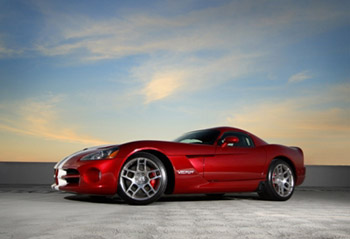
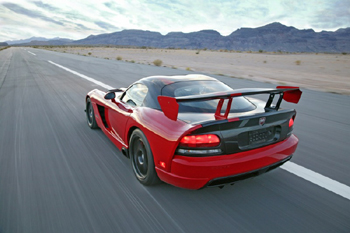 |
|
With its dramatic styling and 600 horsepower, the 2008 Dodge
Viper SRT10 is the ultimate American sports car.
Now with 600 horsepower – 90 more than the
last generation, and
0-to-60 performance in less than four seconds, the Dodge Viper SRT10
sets a new benchmark. |
|
|
|
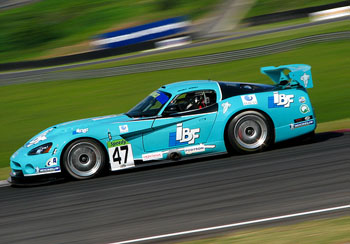 |
|
The Viper has
had a hugely successful career on the race
tracks on both sides of the Atlantic ever
since it went into production more than a
decade and a half ago. Most recently it has
tasted success in the Brazilian GT3
Championship (above) where it clinched the
title in 2007. |
|
|
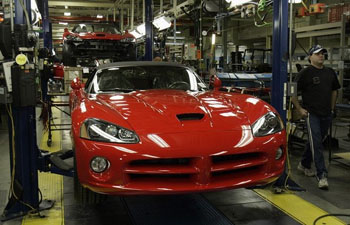 |
|
At the Conner Avenue Assembly Plant, workers
hand-build Viper SRT10 utilising 26 work
stations on a 705-foot-long assembly line,
48 hand-picked UAW workers assemble each
vehicle. Each vehicle remains stationary for
up to 49 minutes per work area as the craft
people make any necessary adjustments. |
|
|
|
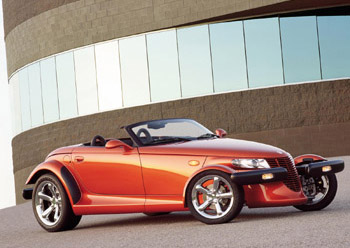 |
|
The
retro-styled Chrysler/Plymouth Prowler was
assembled at the Connor Avenue factory from
1997-2002. Immediately distinctive due to
its open type front wheels the Prowler
featured a 3.5-litre V6 engine and an
aluminium body that partially used bonding
techniques. 11,702 Prowlers were produced. |
|
|
|
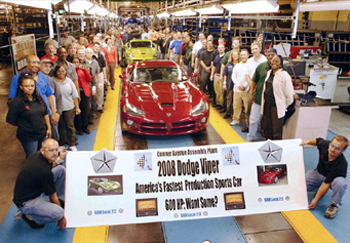 |
|
On October 24,
2007, Chrysler announced the manufacturing
launch of the latest generation version of
the Dodge Viper, dubbed the SRT10, which was
produced as usual at the company's Conner
Avenue Assembly Plant in Detroit. |
|
|
|
The
assets and name rights of Chrysler's legendary niche
sports car, the Viper, have been transferred to
the new Fiat-led Chrysler Group after no serious
bidders were reported to have emerged during the
Chapter 11 restructuring process. Fiat has shown
little interest in acquiring the Viper brand which is hand-built at the Connor Avenue factory in
Detroit, Michigan so it remains to be seen
whether this
will become a long-term asset of the new
Chrysler Group or will be sold of in the short-term.
In the initial deposition to the New York
Bankruptcy Court the Connor Avenue Assembly
Plant was listed amongst the 'bad' assets that
Fiat didn't want to be carried forward into the
new Chrysler Group.
In
the court papers the outgoing Chrysler CEO Bob Nardelli
stated that there had been no serious offers for
Chrysler that stood up to financial scrutiny. However
according to Autoweek several bids
emerged that ran up as high as US$35 million. The bidder with the
strongest interest, who has tabled several proposals
over recent months, is Michigan businessman Scott Devon who plans to
launch a niche super sports car this summer
through his budding Devon Motor Works concern. He is the CEO of Cole's Foods, a Michigan
based business with a US$100 million turnover,
and his low-volume Devon GTX is essentially a Viper chassis
and mechanicals, but with the engine tuned up to 700 bhp
and fitted with a distinct new body made out of Kevlar.
Devon hopes to launch the first working prototype
of this car at Pebble Beach
in August and kick off limited production later
on this year. As well as several offers from Devon, including
a US$20 million in cash bid in March which was,
according to Autoweek, personally rejected by
Nardelli as being too low, and then a higher bid of US$30
million, which included additional government
funding, another Michigan businessman David Elshoff is also reported to have put a bid of
US$35 million in for the Viper concern. Devon
Motor Works' latest bid says Autoweek is
US$5.5 million which includes leasing the
factory for a year. "I think it’s worth a lot
less now than it was two months ago," Devon told the magazine.
Chrysler bought the Connor Avenue factory,
located in Detroit, in 1995, specifically to build the now
Dodge branded Viper sports car which was then being built at the New
Mack Assembly Plant, as well as the Chrysler-and-Plymouth
branded Prowler. The factory had first opened in 1966 to
manufacture Champion spark plugs. After being built at New
Mack from 1992-96 the Viper went into production at Connor
Avenue in 1996, while the unusual retro-looking Prowler came on stream
just over a year
later. While the Viper remains in production today, in
its latest powerful fourth generation guise, the Prowler was phased out in 2002.
Assembly of the Viper's engine was moved to Connor Avenue in
2001 where it is built in a line alongside the car.
The current Viper model has an 8.4-litre
V10 engine with 600 bhp power and 560 lb/ft of torque which
is mated to a
six-speed manual gearbox and it comes in three versions the
STR10 Convertible (US$91,200), the SRT10 Coupe (US$91,970)
and the SRT10 Coupe Package B (US$105,520). Stateside
industry watchers have been surprised by Fiat's lack of
interest in the Viper concern as Fiat CEO Sergio Marchionne
obsesses over high volume targets above all else, particularly as
the niche brand needs to build just 13 cars a day to break even
and showed a profit last year despite parent company
Chrysler's financial woes.
The Viper's stature and image with the American car buying
public provides a valuable 'halo' for
Dodge's lacklustre production model range, and its rival
GM's Corvette concern is its biggest crown jewel, although
these cars are produced on a more mass production scale
while the Viper is hand-built. The Viper has also been
successfully built in quantities as a customer racing car
which has contributed to the division's bottom-line, and
the competition version continues to see high parts sales.
At the Conner Avenue Assembly Plant,
workers hand-build Viper SRT10 utilising 26 work stations on a 705-foot-long
assembly line, 48 hand-picked UAW workers assemble each vehicle. Each
vehicle remains stationary for up to 49 minutes per work area as the
craft people make any necessary adjustments. This process eliminates
traditional repair stations with all procedures verified by team
members.
Each Dodge Viper
model is primarily made of seven
component modules (instrument panel, fuel tank, suspension corner
modules, wheels and tyres, cooling module, lift gate assembly and fully
dressed engine). With the exception of the engine, all modules are
shipped to the Conner Avenue facility from other locations. Stamping, casting
and welding all take place off-site with body panels arriving already
painted.
In a process normally performed only on race
cars, an alignment machine sets caster and camber at normal ride height,
at jounce and at rebound (upward and downward travel of suspension).
Typical factory alignments set caster and camber in the normal ride
height position only. The 2008 Dodge Viper SRT10 is the only U.S.
production vehicle set up for such alignment at the factory.
“Our assembly process is just as
exceptional as the car,” says Melissa Holobach, Plant Manager – Conner Avenue Assembly
Plant,
Sterling Heights Vehicle Test Center (SHVTC) and Pilot Operations.
“The process of building these vehicles by hand has allowed us the
freedom to produce race-inspired performance without the constraints of
mass production,” Holobach said. “Our workforce is committed to
producing the best vehicles possible and it shows in their commitment to
detail.”
The all-new 600-horsepower 8.4-liter SRT V-10
engine is built next to the vehicle on a 24-station circular line by
nine craftsmen. These nine workers assemble and certify each engine
before they are installed in the chassis.
Each Dodge Viper is tested in place on the
assembly line utilising special rollers. At this stage the vehicle is a
rolling chassis without its body panels. During this “roll test” it is
driven through all six speeds of the transmission, up to 90 mph to
verify vehicle function.
Since its
introduction as a concept car at the 1989 North American
International Auto Show in Detroit, the Dodge Viper has
captured the hearts and imagination of enthusiasts around
the world. With its dramatic styling and 600 horsepower, the 2008 Dodge
Viper SRT10 is the ultimate American sports car.
Now with 600 horsepower – 90 more than the last generation, and
0-to-60 performance in less than four seconds, the Dodge Viper SRT10
sets a new benchmark.
|